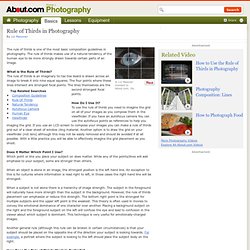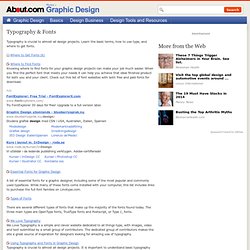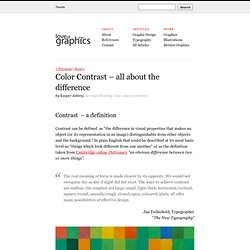

Tips and Projects Center - Photo Tips, Projects, Inspirational Stories and More. Learn Basic Photography. Rule of Thirds in Photography. The rule of thirds is one of the most basic composition guidelines in photography.

The rule of thirds makes use of a natural tendency of the human eye to be more strongly drawn towards certain parts of an image. What is the Rule of Thirds? The rule of thirds is an imaginary tic-tac-toe board is drawn across an image to break it into nine equal squares. The four points where these lines intersect are strongest focal points. The lines themselves are the second strongest focal points. How Do I Use It? Does it Matter Which Point I Use? Photography community, including forums, reviews, and galleries from Photo.net. Photography-2010-imp. Composition and the Elements of Visual Design. Proportion - Golden Ratio and Rule of Thirds Proportion refers the size relationship of visual elements to each other and to the whole picture.

One of the reasons proportion is often considered important in composition is that viewers respond to it emotionally. Proportion in art has been examined for hundreds of years, long before photography was invented. Typography and Fonts - Using Type and Fonts in Graphic Design. Typography is crucial to almost all design projects.

Learn the basic terms, how to use type, and where to get fonts. Where to Find FontsKnowing where to find fonts for your graphic design projects can make your job much easier. When you find the perfect font that meets your needs it can help you achieve that ideal finished product for both you and your client. Check out this list of font websites with both free and paid fonts for download. Essential Fonts for Graphic Design. Design Principles - Harmony.
Why is White Space Good For Graphic Design. Graphic design is a way to communicate a certain message by using typography, visual arts or page layout techniques whether we are talking about newspapers, ads, logos and branding or websites. This form of design is defined by visual communication and it takes some time to master the best of its techniques so that your target audience will understand your message. As in many other domains, graphic design is a process that consists of several main steps that you have to take into consideration. This way you can ease your work, be more organized and meet deadlines in time. It begins with analyzing your audience, stepping through defining the purpose of your message and then establishing what layout and visual graphics you will use in order to send that message. Elements and Principles of Design-Unity. Elements and Principles of Design-Emphasis.
Emphasis creates a focal point in a design; it is how we bring attention to what is most important.

Emphasis is what catches the eye and makes the viewer stop and look at the image. Without emphasis, without getting the viewer to look at the image, communication cannot occur. Emphasis can be created by contrast. An element in contrast with something else is more easily seen and understood; something different attracts the eye. Any of the elements can be contrasted: line (a curve in the midst of straight lines), shape (a circle in a field of squares), color (one red dot on a background of grays and blacks), value (a light or dark area in the middle of its opposite) and texture (rough vs. smooth).
Emphasis can also be created by placement. Elements and Principles of Design-Balance. Balance is the equal distribution of visual weight in a design.

Visual balance occurs around a vertical axis; our eyes require the visual weight to be equal on the two sides of the axis. We are bilateral creatures and our sense of balance is innate. When elements are not balanced around a vertical axis, the effect is disturbing and makes us uncomfortable . Symmetrical, or formal balance, is also known as bilateral symmetry. Framing Your Shots - Photography Composition Technique. A Post By: Darren Rowse We often put the photos we take into frames as a way of displaying and drawing attention to our favorite photos – but there is another type of framing that you can do as you’re taking your shots that can be just as effective doing just the same thing!

Framing is the technique of drawing attention to the subject of your image by blocking other parts of the image with something in the scene. The benefits of framing pictures include: 1. giving the photo context (for example framing a scene with an archway can tell you something about the place you are by the architecture of the archway or including some foliage in the foreground of a shot can convey a sense of being out in nature). 2. giving images a sense of depth and layers (in essence framing a shot generally puts something in the foreground which adds an extra dimension to the shot). 3. leading the eye towards your main focal point (some ‘frames’ can draw your photo’s viewer into the picture just by their shape). Rule of Thirds. Contrast of Color. Color Contrast - all about the difference - Love of Graphics. Contrast – a definition Contrast can be defined as “the difference in visual properties that makes an object (or its representation in an image) distinguishable from other objects and the background.”

In plain English that could be described at its most basic level as “things which look different from one another” or as the definition taken from Cambridge online Dictionary “an obvious difference between two or more things”. The real meaning of form is made clearer by its opposite. We would not recognize day as day if night did not exist. The ways to achieve contrast are endless: the simplest are large/small, light/dark, horizontal/vertical, square/round, smooth/rough, closed/open, coloured/plain; all offer many possibilities of effective design Jan Tschichold, Typographer “The New Typography” Contrast – in color Contrast is the perceived difference in colors that are in close proximity to each other. Value Color Johannes Itten´s Contrasts in Color. A Periodic Table of Visualization Methods.
Visual Literacy. Visual Literacy | Advantages | Art | Charts | Definition | Graphic Organizers | Illustrated Books | Maps | References | Visual Texts | updated September 17, 2005 What is Visual Literacy ?

The International Visual Literacy Association defines visual literacy as the ability to discriminate and interpret visual actions, objects, and other images, while gaining meaning from them. Reading Images: An Introduction to Visual Literacy - Images are all around us, and the ability to interpret them meaningfully is a vital skill for students to learn. Back to the Top Advantages of Visual Learning Visual Learners Learn Best When Taking notes and making lists to read later Reading information to be learned Learning from books, videotapes, filmstrips and printouts Seeing a demonstration. Visual literacy.